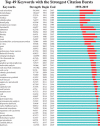Visualized analysis of trends and hotspots in global oral microbiome research: A bibliometric study
- PMID: 34766127
- PMCID: PMC8491219
- DOI: 10.1002/mco2.47
Visualized analysis of trends and hotspots in global oral microbiome research: A bibliometric study
Abstract
The oral microbiome contains numerous bacteria, which directly or indirectly participate in various human functions and continuously exchange signals and substances with the human body, significantly affecting human life cycle, health, and disease. This study aimed to conduct bibliometric studies on the scientific outputs of global oral microbiome research by Citespace software. The data were obtained from the Thomson Reuters' Web of Science Core Collection (WoSCC), from the first relevant literature published until December 31st, 2019, and a total of 2225 articles and reviews were identified. The top country and institutions are the United States and Harvard University. Keywords analysis showed that periodontal disease, oral microbes, and dental plaque are research hotspots. The burst word analysis indicates that early childhood caries, squamous cell carcinoma, gut microbiome, Helicobacter pylori, Candida albicans, and dysbiosis are likely to become the research hotspots of the next era. We also recommend the use of knowledge mapping methods to track specific knowledge areas efficiently and objectively regularly, which can accurately identify hotspots and frontiers and provide valuable information for practitioners in the field, including related scientists, students, journals, and editors.
Keywords: CiteSpace; WoSCC; bibliometric; knowledge map; oral microbiome.
© 2020 The Authors. MedComm published by Sichuan International Medical Exchange & Promotion Association (SCIMEA) and John Wiley & Sons Australia, Ltd.
Conflict of interest statement
The authors declare that there is no conflict of interest that could be perceived as prejudicing the impartiality of the research reported.
Figures





References
LinkOut - more resources
Full Text Sources
